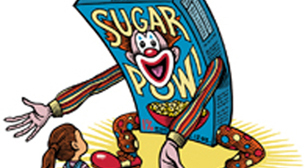 loading
loading
FindingsInside the box Gregory NemecView full imageIf you’re cuckoo for Cocoa Puffs, you and Sonny the bird have lots of company. Very young company, as it turns out. Food companies spent $156 million advertising children’s breakfast cereals in the media in 2008, according to a new report from Yale’s Rudd Center for Food Policy and Obesity. Although the industry has created voluntary standards to encourage companies to promote healthy eating via their advertisements, the Rudd researchers found that little has changed. The average U.S. preschooler sees more than 500 cereal commercials every year—“almost as many ads as the six- to eleven-year-olds,” says Jennifer Harris ’08PhD, lead author of the report, Cereal FACTS. “That was shocking to us.” It’s no revelation that companies market sweet breakfasts to young viewers. But “this is the first time we’ve been able to see that they’re only targeting unhealthy cereals to kids,” Harris says. Notes the report: “Child cereals contain 85 percent more sugar, 65 percent less fiber, and 60 percent more sodium when compared to adult cereals.” Examining the 47 cereals most heavily advertised to kids since late 2006, when the industry adopted its Children’s Food and Beverage Advertising Initiative, researchers found the average amount of sugar dropped only slightly, from 3.5 teaspoons per serving to 3 teaspoons (more than 12 grams). According to Harris, “that’s over a third and up to 40 percent of the content of the cereal.” Change may come. In December, General Mills announced it will cut the sugar content in all of its kids’ cereals to under 10 grams.
The comment period has expired.
|
|